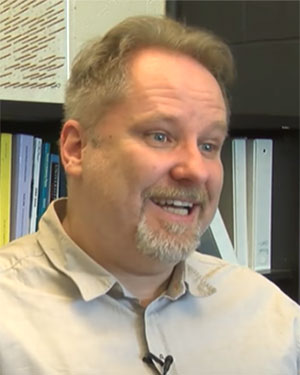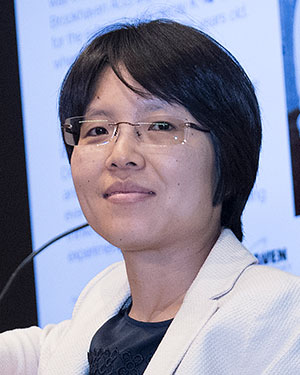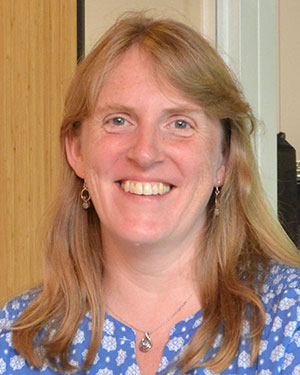RHIC Gets Ready to Smash Gold Ions for Run 23
New sPHENIX detector and a range of upgraded components at STAR will see full-energy heavy-ion collisions for the first time
May 8, 2023
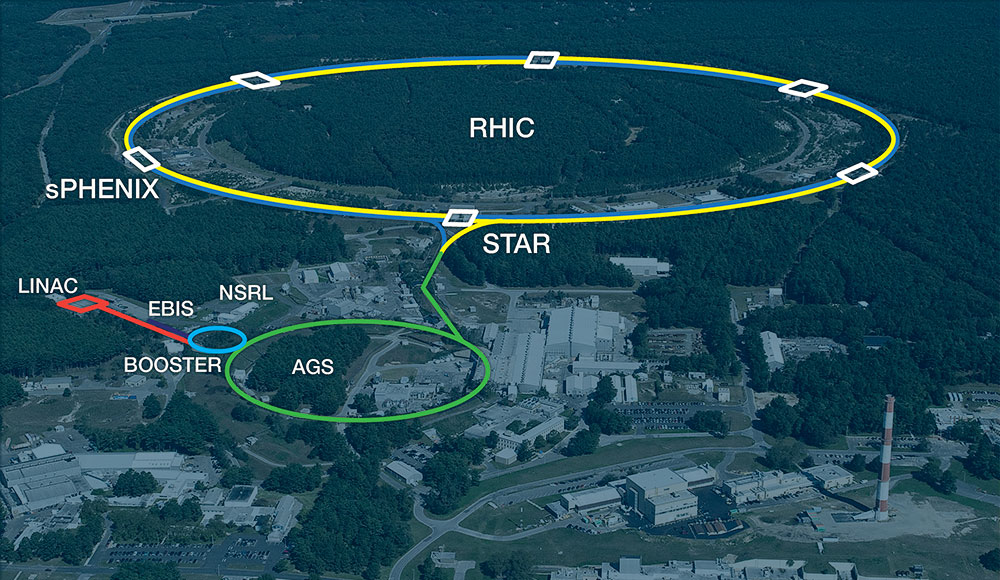 enlarge
enlarge
An aerial view of the Relativistic Heavy Ion Collider (RHIC), a 2.4-mile circumference particle collider at Brookhaven National Laboratory, showing the locations of the STAR and sPHENIX detectors. Run 23 will be the first for sPHENIX and the 23rd for STAR.
The start of this year’s physics run at the Relativistic Heavy Ion Collider (RHIC) also marks the start of a new era. For the first time since RHIC began operating at the U.S. Department of Energy’s Brookhaven National Laboratory in 2000, a brand new detector will track what happens when the nuclei of gold atoms smash into one another at nearly the speed of light. That new detector, sPHENIX, has been a decade in the making. It has a host of components for making precision measurements never possible before at RHIC.
RHIC’s STAR detector, which has been running and evolving since 2000, will also see some firsts in Run 23. Its most recently upgraded components allow the detector to “see” more particles streaming out of collisions closer to the collision point and at wider angles than ever before. This suite of components, which operated successfully in lower-energy collisions, will now collect data from full-energy collisions for the first time. In addition, STAR physicists look forward to flexing the detector’s capacity for capturing up to 5,000 collision events per second, more than double its rate in any previous year.
“There’s a very rich physics program to be run and great interest worldwide—and in the media—in this physics program,” said Jamie Dunlop, Brookhaven Lab Physics Department Associate Chair for Nuclear Physics, pointing out a recent article in Scientific American about this year’s plans for RHIC.
One reason for that interest? RHIC’s research delves into the matter that makes up everything visible in the universe today—stars, planets, and even you and me. RHIC scientists use particle collisions to study that matter by effectively turning back the hands of time.
Colliding atomic nuclei at very high energies melts the boundaries of individual protons and neutrons, setting free those particles’ innermost building blocks: quarks and gluons. Such a system of “free” quarks and gluons—known as a quark-gluon plasma (QGP)—existed in nature some 14 billion years ago, a millionth of a second after the birth of the universe, before protons and neutrons formed. Studying this substance using detectors like STAR and sPHENIX offers clues to why matter behaves the way it does.
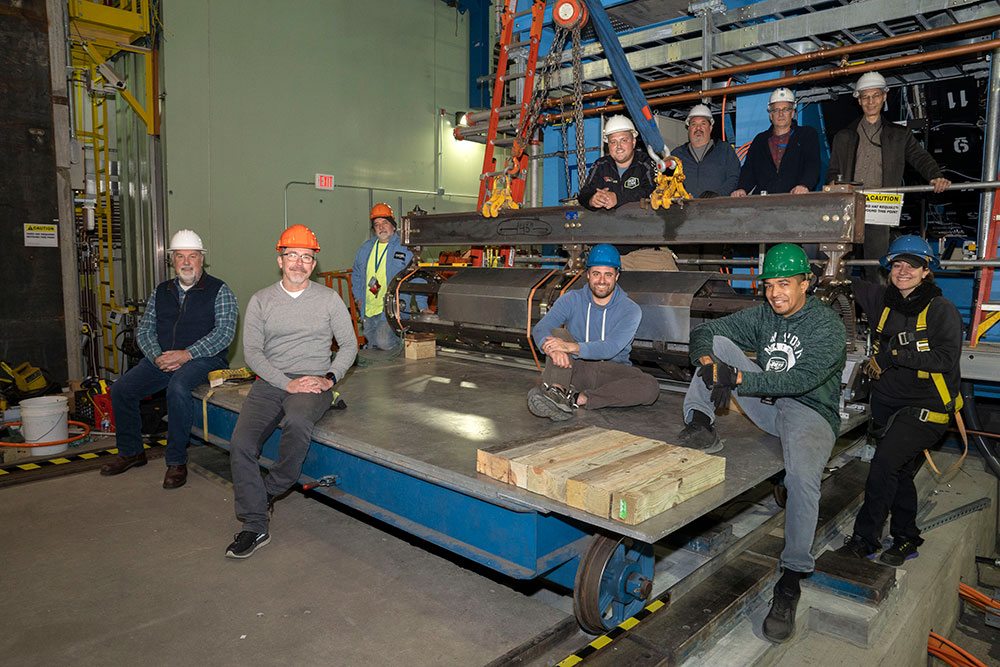 enlarge
enlarge
sPHENIX co-spokesperson David Morrison (front, orange hard hat) with part of the team installing the final sector of the sPHENIX electromagnetic calorimeter: (front row, left to right) Jim Mills, C-AD engineer; Jeff Hoogsteden, Aaron Allen, and Shana Prifte — all Physics Department technicians; (standing rear, upper level) Chris Cordovano, Physics Department technician; Damon Miraglia, C-AD technician; Sean Stoll, physicist; Mike Lenz, Physics Department technician; (standing rear, lower level) James Sadloski, Facilities & Operations heavy machine operator.
Why a new detector?
“The initial thought behind RHIC was does the QGP exist?” said Brookhaven Lab physicist and sPHENIX co-spokesperson Dave Morrison. “Then a big part of what RHIC and the heavy-ion program at the Large Hadron Collider (LHC) have done has been exploring how the QGP behaves, what are its properties?”
Massachusetts Institute of Technology (MIT) physicist Gunther Roland, the other sPHENIX co-spokesperson, noted, “We have answers to those questions over the last 15 years or so. Now we want to move to a new set of questions—to understand how these properties arise from the underlying interactions of quarks and gluons. Nobody knows the answer to that. We realized we needed a new experiment to provide those answers.”
The science goals of the sPHENIX detector were highlighted in the 2015 Long Range Plan for Nuclear Science, a roadmap that guides U.S. research in the field. The detector has precision components to collect the data needed to answer very specific questions about jets (collimated collections of particles produced in collisions) and a family of quark-antiquark particles known as upsilons.
Studying the way different upsilons interact with the matter created in RHIC collisions, Morrison said, “is like putting a tape measure inside the QGP and measuring something about the distance over which the forces that are affecting quarks and gluons operate.” And tracking the angles at which the particles that make up jets traverse the plasma, and the energy or momentum they have, “gives us different handles on the ways QGP affects how quarks and gluons interact.”
But before the scientists can make those precision measurements, they will ensure the detector they’ve built over the past seven and a half years operates correctly.
Commissioning sPHENIX
“sPHENIX is a very complex detector with many distinct systems, and the extensive process of commissioning everything will be the top priority of the 2023 run,” Morrison said.
“Many hundreds of people have been working on sPHENIX for many years and there’s a lot of excitement,” Roland added. “But one needs to proceed with great care and in a very systematic fashion.”
For one thing, while RHIC will operate at its highest energy for heavy ion collisions (200 billion electron volts, or GeV, per colliding pair of nuclei), its luminosity—the rate of collisions—will be kept deliberately low for at least the first several weeks of the run.
“We will systematically verify the operation of each of the detector systems—starting with the simplest ones that provide the trigger (telling us if there is a collision or not) to some of the most complex detectors that have ever been employed in high energy nuclear physics,” Roland said.
The sPHENIX crew is planning a period of systematic troubleshooting.
“There are always little mysteries that pop up and then need to be solved as you commission this sort of one-of-a-kind detector—or collection of one-of-a-kind devices—for the first time,” Roland noted.
They’ll do some measurements for which they already know the answer and make whatever adjustments are needed to be sure all the detector components are working together to capture details of each collision. Thinking about what happens at full luminosity makes it clear why this process is much easier with fewer collisions happening.
“At full luminosity you can have a collision every 100 nanoseconds. So quite a few collisions can happen, each of them putting tracks into the ‘time projection chamber’ (TPC) of the detector,” Morrison said. All the electrons that make up those tracks drift along, potentially overlapping and interfering with one another.
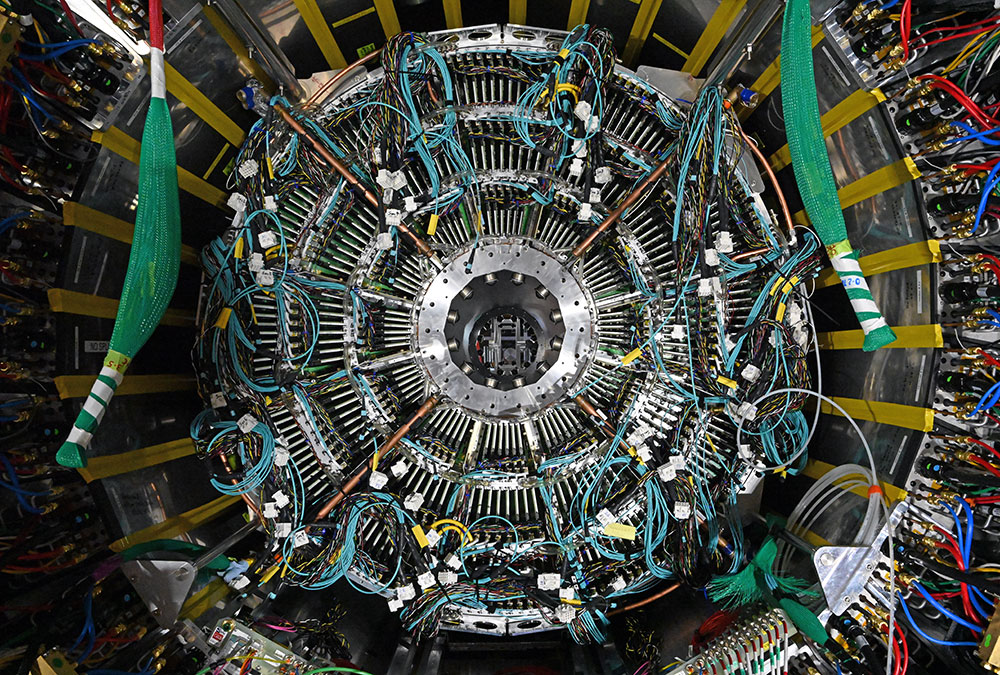 enlarge
enlarge
An end-view of the Time Project Chamber of the sPHENIX detector, which will be seeing its first collisions during Run 23 at the Relativistic Heavy Ion Collider (RHIC). The top priority of the run will be commissioning all the complex components of sPHENIX.
There’s also a complex system of lasers inside the TPC, which will produce known electron tracks scientists use to compare with those generated by particles emitted from collisions.
“It’s going to be like a discothèque inside with lasers going every which way,” Morrison said. “We need to make sure we understand how the lasers work, how the TPC works, and all the other components when there aren’t very many collisions per second before we ramp up to full luminosity.”
“Soft” explorations at STAR
Meanwhile, even with low collision rates at the beginning of the run, STAR will be making use of the high collision energy.
“The last 200 GeV gold-gold run at RHIC was in 2016,” said STAR co-spokesperson Lijuan Ruan, a physicist at Brookhaven. Since then, she explained, one detector component that was great for measurements needed at the time but that reduced the resolution of other measurements has been removed—thus promising increased resolution for this run. In addition, a slew of STAR component upgrades has increased the detector’s ability to track particles closest to the collision point and also at the widest angles ever in the “forward” direction at one end of the detector.
“Run 23 is the first time all those detector upgrades will see particles emerging from interactions at RHIC’s top collision energy,” Ruan said.
During this run and the planned run for 2025, which will also collide gold ions at 200 GeV, the STAR team will use those components and the rest of STAR’s capabilities to collect high-statistics data on particles with very low energy or transverse momentum. Extending measurements of these so-called “soft observables” into the forward region, for example, can help reveal global properties of the QGP. Examples include how particles flow collectively through the plasma, the temperature dependence of variables such as viscosity, and the degree to which variations in the interactions among quarks and gluons influence the spin alignment of particles streaming out.
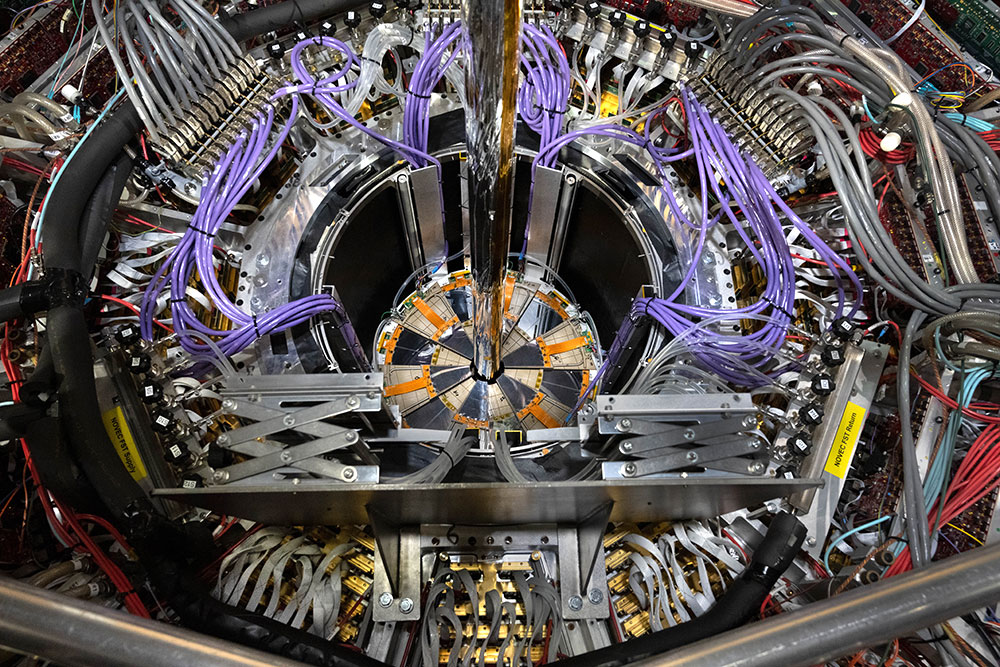 enlarge
enlarge
The silicon tracker detector modules installed around the beampipe at one end of the STAR detector at the Relativistic Heavy Ion Collider (RHIC) are just one of the recently upgraded STAR components that will see full-energy gold-gold collisions for the first time during Run 23.
“Previously, we were looking at one observable or another at a time and comparing those measurements with predictions from models to get conclusions,” Ruan said. “But now, with the new detector capabilities and high statistics, we are entering a precision era using multiple observables—a multi-messenger approach—to look at them globally. That will inform our understanding of the evolution of heavy ion collisions and the properties of the QGP.”
To get those high statistics, STAR will also make use of a recent upgrade that more than doubles the readout speed of its TPC. Previously able to record a maximum of 2000 events per second, the STAR TPC can now capture up to 5000 collisions in less than the blink of an eye.
With the run starting at relatively low luminosity, STAR physicists may not be able to push their detector to that max level until later this summer. But they understand the need to provide sPHENIX with the conditions needed to come up to speed.
“Commissioning their detector is the most important thing for this run. We will collect data, but sPHENIX is going to be driving the run,” said Yale University physicist Helen Caines, who recently concluded her six-year term as a STAR co-spokesperson.
When the collision rates ramp up, STAR will be ready.
“We have the best particle acceptance, highest-rate detector that we’ve had at STAR at this point, so we’re going to collect data with the best and most comprehensive suite of detectors we’ve had to date,” Caines said. “This will be a data set that we can analyze for a long time into the future.”
Bring on the luminosity
The sPHENIX collaboration is also eager to get to full luminosity to begin addressing the physics questions it was designed to answer.
“Our plan is for several weeks of data taking for physics, which would happen after commissioning the detector,” sPHENIX collaboration co-spokesperson Morrison said. “There’s a ton of physics that sPHENIX can do with that data.”
The new detector’s mission will focus on hard probes—energetic particle jets and particles made from heavy quarks, which require a lot of energy to generate.
“We’ll get RHIC’s first look at jets that come from the fragmentation of the very heavy bottom quark with fantastic statistical precision. These measurements can explore what happens to pairs of jets in a collision, for example those produced at different orientations relative to the rest of the particles coming out,” Morrison said. “That can help tell us how the truly microscopic interactions of quarks and gluons produce QGP properties like its perfect fluidity.”
“We’ll start seeing what happens to the three different members of the upsilon family of mesons,” each made of a bottom quark bound to an antibottom quark but with different binding energies, he noted. Those measurements will give the scientists information about the length scale of the strong-force interactions among quarks and gluons, and potentially the temperature of the QGP.
The point of sPHENIX, MIT’s Roland said, “is to get a complete picture of the collisions in terms of these hard probes and in terms of their correlations with the soft particles that represent the bulk of the QGP once it turns back into hadrons [composite particles made of quarks and/or antiquarks].”
Some of those measurements will rely on additional gold-gold collision data collected in the 2025 run, and proton-proton collisions in 2024, which will provide essential comparison data.
“The full physics program requires as much data as can possibly be collected in RHIC’s remaining runs to give us the statistical reach to complete the sPHENIX program,” Roland said.
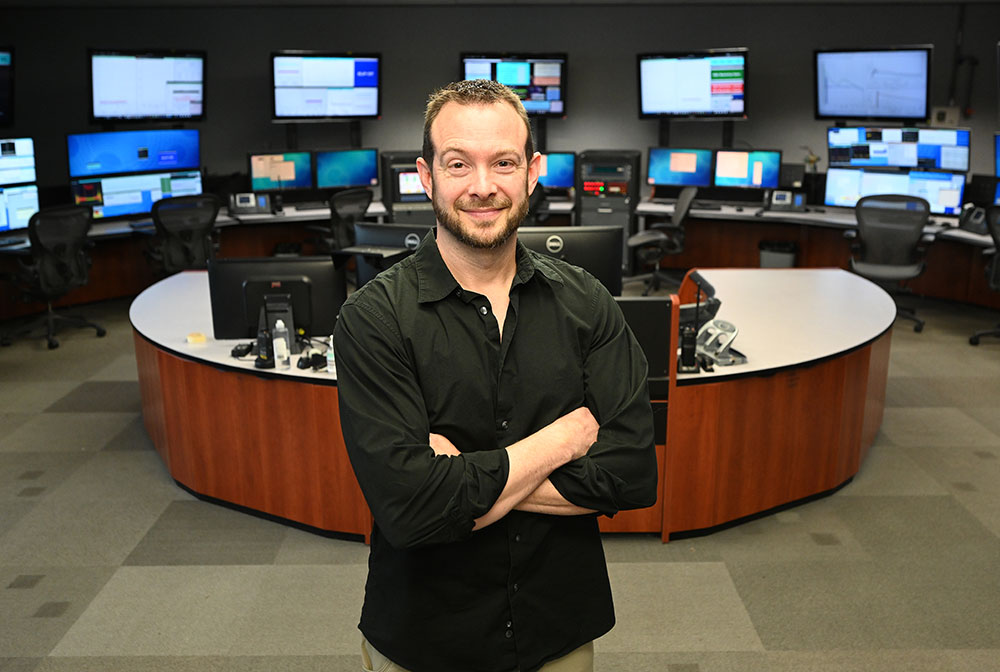 enlarge
enlarge
Travis Shrey, run coordinator for Run 23 at the Relativistic Heavy Ion Collider (RHIC), in the Main Control Room of the Collider-Accelerator Department at Brookhaven National Laboratory.
Generating the collisions
RHIC’s experiments rely on accelerator physicists’ ability to deliver particle beams at specified energies and rates within each detector. Under the guidance of Run 23 Coordinator Travis Shrey, the Collider-Accelerator Department (C-AD) staff at this DOE Office of Science user facility will demonstrate their strengths and the machine’s versatility.
 enlarge
enlarge
Wolfram Fischer, chair of the Collider-Accelerator Department at Brookhaven National Laboratory.
As noted, the run will start with beams of gold ions (the nuclei of gold atoms stripped of their electrons) entering RHIC’s two counter-circulating rings at low intensity—meaning fewer bunches of particles and fewer particles per bunch—to keep the number of collisions low. But each beam will be accelerated to collide at full energy inside the sPHENIX and STAR detectors located at interaction regions where the two rings cross.
RHIC has traditionally operated with the two beams traveling in opposite directions passing straight through one another inside the detectors. This allows collisions to occur between particles in the opposing beams across the entire length of each pair of colliding bunches. But for this run, the particles will travel a different path to cross one another at an angle.
“This crossing angle creates a narrower collision zone, which will improve the performance particularly of the sPHENIX detector,” said Wolfram Fischer, chair of C-AD.
During sPHENIX commissioning, accelerator physicists will use a range of tools to monitor the size and positions of the beams—and techniques to control those beam properties—to maintain a slow but constant collision rate at STAR.
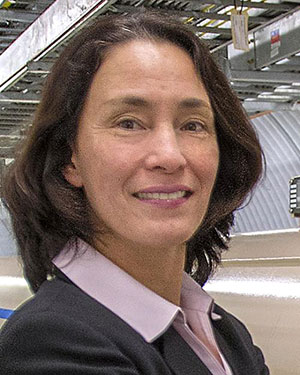 enlarge
enlarge
Michiko Minty, head of the Accelerator Division of the Collider-Accelerator Department at Brookhaven Lab.
Monitoring and optimizing beams will continue as the collision rate ramps up, taking advantage of a newly recommissioned “stochastic cooling” system and a refurbished superconducting radiofrequency (RF) cavity.
“Sensors in the stochastic cooling system measure small random fluctuations in the positions of the particles within each bunch of particles and send signals to ‘kicker’ cavities that nudge the particles back together. These nudges result in more dense bunches,” explained Michiko Minty, head of the Accelerator Division of C-AD. “Similarly, the 56-megahertz RF cavity, together with the other RF cavities, will prevent bunches from lengthening due to intrabeam scattering.”
All this squeezing and shortening of ion bunches increases the chance that the ions will collide. It also helps maintain the shorter beam-crossover region inside the sPHENIX detector.
“Higher beam intensities will also be available thanks to a recent upgrade in the Electron-Beam Ion Source (EBIS),” Minty said. EBIS is the machine that generates RHIC’s heavy ion beams and injects them into the accelerator chain that feeds the beams into the collider. “This year we’ll be operating with up to 40 percent more gold beam than in any previous run,” she said.
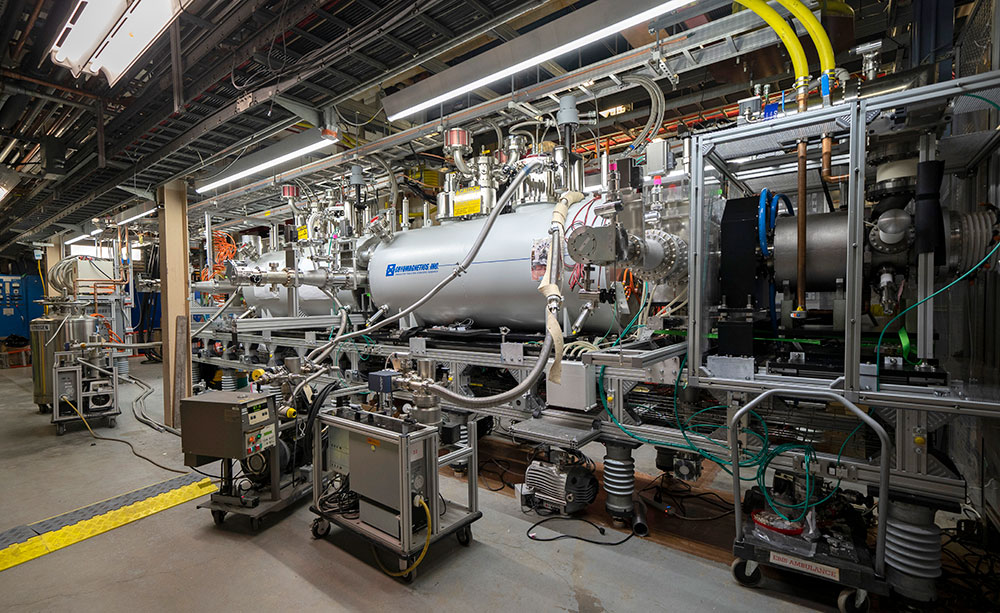 enlarge
enlarge
The new Extended Electron Beam Ion Source (EBIS) at the Relativistic Heavy Ion Collider (RHIC) will have more intensity than its predecessor, delivering up to 40 percent more gold beam into the collider than in any previous run.
In addition to delivering gold to the experiments, the C-AD staff will be implementing new systems for protecting the detectors when RHIC’s beams are dumped periodically. They’ll also be conducting tests of additional beam-cooling systems and acceleration schemes that will play a role in post-RHIC C-AD operations at Brookhaven, when many of RHIC’s accelerator components are transformed into an Electron-Ion Collider (EIC).
“We plan to make use of every second of this run to help sPHENIX and STAR accomplish their goals and to explore all the ways we can get the most out of the world’s most versatile particle accelerator and collider complex—both now and in the future,” Fischer said.
RHIC operations and much of its research are funded by the DOE Office of Science (NP).
Brookhaven National Laboratory is supported by the Office of Science of the U.S. Department of Energy. The Office of Science is the single largest supporter of basic research in the physical sciences in the United States and is working to address some of the most pressing challenges of our time. For more information, visit science.energy.gov.
Follow @BrookhavenLab on Twitter or find us on Facebook.
2023-21190 | INT/EXT | Newsroom




